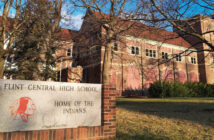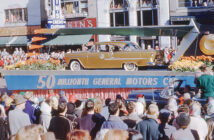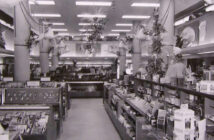Throughout MCM’s exploration of General Motors’ history, we’ve focused on the inchoate beginnings of what was later the model of efficiency and the power of precision. But who enacted this change? Who made the name of General Motors synonymous with industrial production? Answer: Alfred P. Sloan, Jr.
Undoubtedly, Alfred Sloan is a mysterious figure. The president of GM from 1923-1946, Sloan not only built it into a corporate titan; he wielded his influence to shape American society into what it is today: a consumer-driven culture dominated by corporate power. Although his influence in daily American life is ubiquitous, precious few details are known about his personal life. A perusal of his seminal work on business operation, My Years with General Motors, is devoid of any emotion, not to mention personal information. His autobiography, Adventures of a White-Collar Man, contains hardly any more: only a few mentions of his wife, Irene, one of which is a dedication that reads, “Dedicated to I.J.S., my partner in the enterprise.” Ironic, considering that Irene never had anything to do with General Motors. Sloan left no private papers and provided no one with the opportunity to peer into his personal life. He and his wife had no children to share personal accounts. His legacy, carefully shaped by himself alone, is entirely business-related. In fact, two main sources utilized by biographers wishing to write on Sloan are the works mentioned above.
Sloan was born May 23, 1875 in New Haven, CT, the oldest child of his two parents. Almost nothing is known of his adolescence, and the young boy himself seemed eager to leave behind his childhood, as he graduated (a year early) in 1895 from MIT with a degree in Electricity. The Panic of 1893 had pinched the economy, but through his father’s acquaintance, Sloan got a job as a draftsman at the Hyatt Roller Bearing Company. Although the bearing produced was innovative, with potential to be adapted to great usefulness, the company was poorly run. In 1898, the year Sloan married his wife, he became partners in the Hyatt Roller Bearing Company, which was dissolving for lack of funds. With help from his father, Sloan and his partner turned the company around.
Sloan’s rise to corporate stardom began in 1899. An automobile maker – more accurately described as a tinkerer – inquired about the roller bearing for use in his machine. A year later, another order came in, this one from Olds Motor Works. As Hyatt expanded, one of their new clients was Henry Leland, the precision-obsessed maker of Cadillac. Leland chastised Sloan for the lack of uniformity in his bearings. Sloan recalled the effect of that meeting in this way: “After I had said good-bye to Mr. Leland, I began to see things differently. I was determined to be as fanatical as he in obtaining precision in our work.” After that, Hyatt took off. Being closely affiliated with the Weston-Mott Axel Company, they serviced Oldsmobile, Ford, Cadillac, Buick and a host of others. The biggest problem for automobile manufactures at that time was the reliable supply of parts for production, but for parts suppliers like Hyatt, there was a constant fear that the manufacturer would begin producing their parts in-house, effectively eliminating the need for companies like Hyatt. For this reason, when GM President W.C. Durant offered to buy Hyatt in 1916, Sloan acquiesced.
Hyatt was officially purchased by the United Motors Corporation, a conglomerate of parts makers that did not merge with General Motors until 1918. As president of the United Motors Corporation and later vice-president of General Motors, Sloan was in close contact with Durant: his vision, optimism and blunders. In 1920, when Durant lost control of GM for the final time, Sloan had been thinking of resigning his position due to Durant’s frenetic decision-making. It was well he hadn’t resigned, for three years later he was elected president of the giant company. Sloan would make it even bigger. In fact, Allyn Freeman, author of The Leadership Genius of Alfred P. Sloan, says, “When Sloan retired as chairman of the GM board in 1956, General Motors had grown exponentially to become one of the largest corporations in the world. Its five manufacturing divisions dominated the American market.” With a true brilliance for management, Sloan changed every aspect of U.S. automobile manufacture and production. In doing so, Freeman says “he also revolutionized the world of the American corporation like no one had done before him or may ever do again.”
Sloan’s recollection of his appointment to president shows his complete and utter devotion to his work: “I believe it is reasonable to say that no greater opportunity for accomplishment ever was given to any individual in industry than was given to me when I became president of General Motors. I fully realized that, and I fully appreciated it. And I always have been grateful for the confidence that made it possible. I determined right then and there that everything I had was to be given to the cause. No sacrifice of time, effort, or my own convenience was to be too great. There were to be no reservations and no alibis.”
Sloan was a man of machines and corporations. There is little evidence to suggest that he ever wanted anything more than his career. In only one incident did Sloan show any regret for the way he had lived his life. Warren Weaver, whom Sloan wished to appoint to the presidency of the Sloan Foundation in 1956, was hesitant about the position because he was concerned that he would not have enough time to spend with his wife. Sloan’s wife had died earlier that year, and Sloan reportedly told Warren, “If I ever ask you to do anything that limits your companionship with your wife, you just tell me to go to hell. I understand completely. For many years I was too completely absorbed in my business. I always said that I would cut down on this, and spend more time with my wife. But Warren, I waited too long.” Perhaps Sloan was more than just a machine man inside, but he made sure the world would never know.







